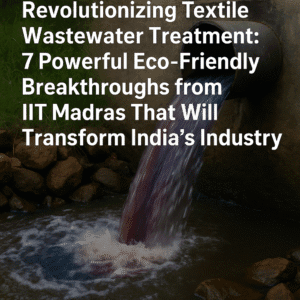Revolutionizing Textile Wastewater Treatment: 7 Powerful Eco-Friendly Breakthroughs from IIT Madras That Will Transform India’s Industry
India’s textile industry, vital to its economy, faces a mounting environmental challenge: toxic wastewater laden with dyes, salts, and chemicals. Addressing this, IIT Madras has unveiled an innovative, cost-effective technology combining Electrochemical Ozone Oxidation (ECOOP) and Capacitive Deionization (CDI). ECOOP eliminates 96% of dyes and 60% of organic pollutants without chlorine—preventing carcinogenic byproducts—while CDI removes salts using 30-50% less energy than traditional reverse osmosis.
Successfully piloted in Tamil Nadu’s Tirupur district, the system slashes treatment costs by 25%, reduces RO infrastructure needs by 75%, and aligns with UN sustainability goals. By prioritizing scalability and affordability, especially for smaller units, this breakthrough offers a blueprint for global industries to balance growth with ecological responsibility, safeguarding water resources and public health.

Revolutionizing Textile Wastewater Treatment: 7 Powerful Eco-Friendly Breakthroughs from IIT Madras That Will Transform India’s Industry
The vibrant colors of India’s textile industry, a cornerstone of its economy, have long come at a hidden cost: toxic wastewater that pollutes waterways, endangers ecosystems, and threatens public health. But a groundbreaking innovation from IIT Madras could finally turn the tide. Researchers have developed a cost-effective, chlorine-free technology to treat textile effluent, offering a scalable solution to one of the industry’s most pressing challenges.
The Problem: A Pollution Crisis in Plain Sight
India’s textile sector contributes 5% to GDP and employs millions, but its environmental footprint is staggering. Dyeing and finishing processes generate wastewater laden with carcinogenic dyes, heavy metals, and salts. Conventional Zero Liquid Discharge (ZLD) systems—mandated to recover and reuse water—are prohibitively expensive for many units, guzzle energy, and rely on chlorine, which creates harmful byproducts. Worse, inefficient treatment reduces water clarity, blocks sunlight for aquatic photosynthesis, and introduces toxins into food chains.
The Innovation: How ECOOP + CDI Changes the Game
IIT Madras’s solution tackles two core issues: organic pollutants (like dyes) and salt content. Their dual approach combines:
Electrochemical Ozone Oxidation Process (ECOOP):
- Destroys 96% of dyes and 60% of organic pollutants without chlorine.
- Avoids toxic sludge and carcinogenic byproducts.
- Targets the “dyebath” (10% of effluent), which holds 90% of contaminants.
Capacitive Deionization (CDI):
- Removes salts using 30-50% less energy than reverse osmosis (RO).
- Ideal for treating the remaining 90% “wash water” with lower salt levels.
Result: A 75% reduction in RO infrastructure costs and 25% lower overall treatment expenses compared to traditional ZLD.
Pilot Success: From Lab to Real-World Impact
Deployed at Tirupur’s Kunnakalpalayam CETP—a major textile hub in Tamil Nadu—the pilot treated 400 liters/day, proving its viability:
- 96% color removal and 60% reduction in chemical oxygen demand (COD).
- Eliminated chlorine use, aligning with global sustainability goals (SDGs 6, 12, 13, 14, 15).
- District Collector Shri T Christuraj lauded the project as a “model for eco-conscious industrial growth.”
Why This Matters Beyond Compliance
- Economic Accessibility: Smaller units, often priced out of ZLD adoption, can now afford treatment.
- Environmental Justice: Cleaner water reduces health risks for communities near dyeing units.
- Global Relevance: With 20% of global water pollution tied to textiles, this tech could reshape industry practices worldwide.
The Road Ahead: Scaling for Greater Impact
Professor Indumathi M. Nambi’s team is optimizing the system to handle diverse effluent types and expanding partnerships with German institutions (Goethe University, RWTH) and Indian agencies like TWIC. Future goals include:
- Customizing ECOOP for small-scale dyeing units lacking RO infrastructure.
- Hosting workshops to train industries in eco-toxicology and sustainable practices.
- Reducing operational costs further to accelerate adoption.
A Blueprint for Sustainable Industry
This innovation isn’t just about cleaner water—it’s a model for reconciling industrial growth with planetary health. By slashing costs and carbon footprints, IIT Madras offers a pragmatic path for emerging economies to meet SDGs without sacrificing development. As Prof. Nambi notes, “Our technology isn’t a choice; it’s a necessity for industries surviving in a climate-conscious world.”
For Tirupur’s textile clusters and beyond, the message is clear: sustainability and profitability can coexist, one drop of treated water at a time.
You must be logged in to post a comment.